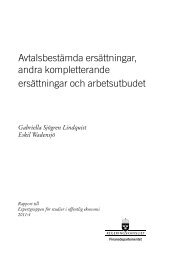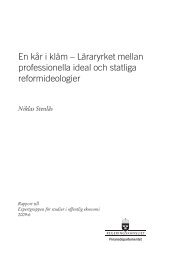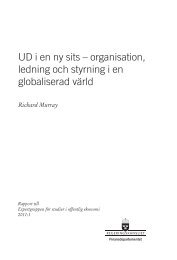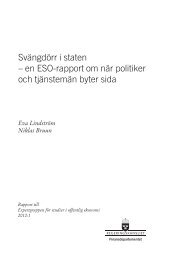Läs rapporten här - Expertgruppen för Studier i Offentlig ekonomi
Läs rapporten här - Expertgruppen för Studier i Offentlig ekonomi
Läs rapporten här - Expertgruppen för Studier i Offentlig ekonomi
You also want an ePaper? Increase the reach of your titles
YUMPU automatically turns print PDFs into web optimized ePapers that Google loves.
Summary 2012:5<br />
Stockholm Metro was a socioeconomic efficient investment. It<br />
should be emphasized that since the CBA concerns the current<br />
Metro, it gives no indication of the socioeconomic benefits of a<br />
possible expansion of the Stockholm Metro at present.<br />
One reason for carrying out a CBA for the Stockholm Metro is<br />
to explore the robustness of the CBA methodology. This case<br />
study of the Stockholm Metro takes the models and CBA<br />
methodology to their limits. This is because the methodology is<br />
less developed for large investments in growing urban regions than<br />
for other investments. This, in turn, is due mainly to the fact that it<br />
is difficult to estimate the benefits of investments that have longterm<br />
dynamic effects on the labor market and that have effects on<br />
congestion in the road network. Another reason for choosing the<br />
Metro is the widespread anecdote that the Metro would not have<br />
shown a positive CBA outcome when it was built, which often is<br />
said to undermine the trust in CBA.<br />
Even if this project demonstrates that some of the criticism of<br />
the CBA methodology is valid for certain types of investments (see<br />
next section - the benefits are underestimated), the Metro shows<br />
positive estimate outcomes. This lends some legitimacy to the<br />
CBA methodology and gives some support to the robustness of<br />
the methodology.<br />
The benefits are underestimated<br />
Although this project shows that the Metro was socioeconomic<br />
beneficial to build in the 1950s, some weaknesses of the standard<br />
methodology are also demonstrated. Specifically that the benefits<br />
of urban investment are typically underestimated for several<br />
reasons.<br />
One purpose of this report is - in addition to test the robustness<br />
of the CBA methodology - to expose the strengths, weaknesses<br />
and development potential of the methodology. We hope that this<br />
will provide some guidance concerning the robustness of the CBA<br />
methodology and for what types of investments the benefits are<br />
likely to be underestimated. This should be helpful in the<br />
interpretation of the CBA outcomes.<br />
First, the benefit may be underestimated because long-term<br />
dynamic labor market effects are not captured in standard CBA.<br />
They are likely to be substantial in cases like the Stockholm Metro,<br />
14








